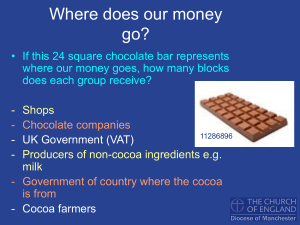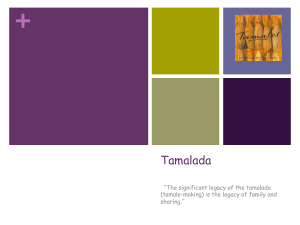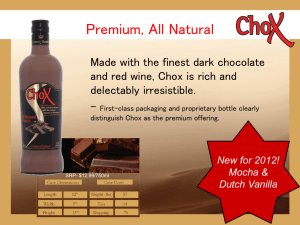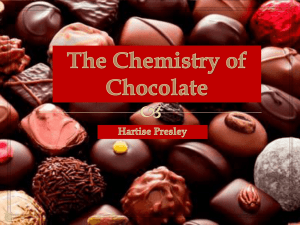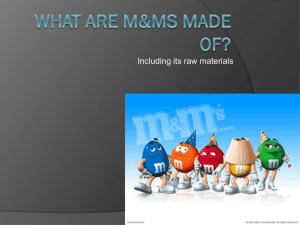“Chocolate: The New Health Food. Or Is It?” (Worksheet 3)
advertisement
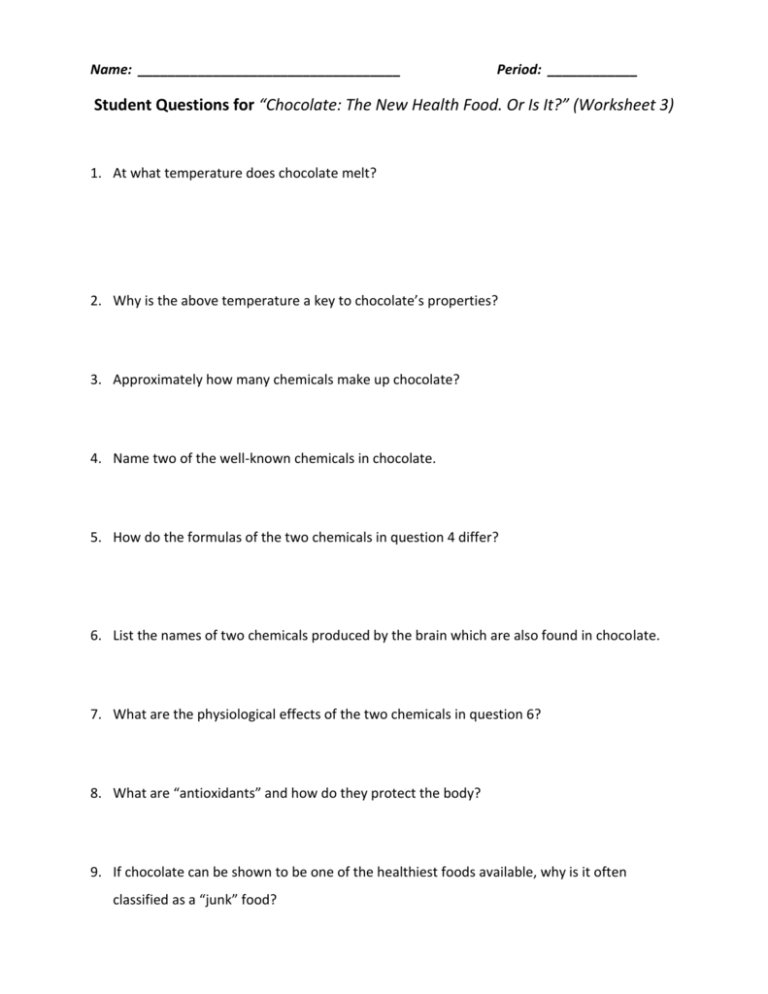
Name: ___________________________________ Period: ____________ Student Questions for “Chocolate: The New Health Food. Or Is It?” (Worksheet 3) 1. At what temperature does chocolate melt? 2. Why is the above temperature a key to chocolate’s properties? 3. Approximately how many chemicals make up chocolate? 4. Name two of the well-known chemicals in chocolate. 5. How do the formulas of the two chemicals in question 4 differ? 6. List the names of two chemicals produced by the brain which are also found in chocolate. 7. What are the physiological effects of the two chemicals in question 6? 8. What are “antioxidants” and how do they protect the body? 9. If chocolate can be shown to be one of the healthiest foods available, why is it often classified as a “junk” food? 10. Cocoa is rich in chemicals called flavanols. What are some of the health benefits of flavanols? 11. It is a popular belief that chocolate causes acne and other skin problems that afflict teenagers. According to the article, is this true? Explain. 12. Briefly describe the steps in chocolate production. 13. What is the chemical composition of cocoa butter? 14. What are scientists doing to find ways to make cocoa trees more resistant to pests and disease and provide healthier, more nutritious, and better tasting chocolate? Answers to Student Questions for “Chocolate: The New Health Food. Or is it?” 1. At What temperature does chocolate melt? Chocolate melts between 94 and 97 oF. 2. Why is the above temperature a key to chocolate’s properties? Normal body temperature is 98.6 oF, just above the melting point of chocolate. “Melts in your mouth” is true. “A morsel of chocolate slides across your tongue and liquefies into a perfect puddle of taste sensation.” 3. Approximately how many chemicals make up chocolate? According to the article, chocolate contains more than 300 chemicals. 4. Name two of the well-known chemicals in chocolate. The two chemicals are caffeine and theobromine. Caffeine is present in small amounts, with theobromine present in slightly higher amounts than caffeine. 5. How do the formulas of the two chemicals in question 4 differ? The two chemicals are identical except for one methyl group (CH3-) present in the caffeine molecule, but not in the theobromine molecule. Caffeine theobromine 6. List the names of two chemicals produced by the brain which are also found in chocolate. The two chemicals produced by the brain which are also found in chocolate are anandamide and phenylethylamine. 7. What are the physiological effects of the two chemicals in question 6? Anandamide blocks out pain and depression. Chemicals in chocolate appear to slow down or inhibit the breakdown of anandamide and, as a result, the chemicals’ persistent presence makes us feel good longer. Phenylethylamine stimulates the parts of the brain that keep one alert and mimics the brain chemistry of a person in love. 8. What are “antioxidants” and how do they protect the body? Antioxidants protect the body from free radicals – atoms, molecules, or ions with unpaired electrons. The unpaired electrons are usually highly reactive and more likely to take part in chemical reactions. Inside cells, free radicals damage DNA and have been associated with Alzheimer’s disease, heart disease, and cancer. Antioxidants prevent this damage from happening by blocking the action of free radicals. 9. If chocolate can be shown to be one of the healthiest foods available, why is it often classified as a “junk” food? It is all in the processing of the chocolate. Processing determines whether chocolate is a healthy food or a high calorie indulgence. Roasting and fermenting wipe out scores of antioxidants. Food stores sell mainly processed chocolate, with sugar, milk, and extra fat added because they taste good and cost less, but the more non-cocoa items added to cocoa, the more dilute the healthy chemicals become. And the cheaper the cost, in general, the more a chocolate qualifies as a junk food. 10. Cocoa is rich in chemicals called flavanols. What are some of the health benefits of flavanols? Flavanols appear to increase blood flow to the brain and, as a result, might be used to treat vascular impairments in the brain resulting from a stroke. Consumption of a flavanol-rich cocoa beverage also increases the amount of nitric oxide in the blood vessels, allowing them to dilate and keep them pliable. Cocoa flavanols might then be used to clear clogged arteries in heart disease and stroke. 11. It is a popular belief that chocolate causes acne and other skin problems that afflict teenagers. According to the article, is this true? Explain. Current research does not connect any specific food to skin problems. Chocolate husks contain chemicals that prevent tooth decay, although the added sugar in chocolate confections may offset the health benefits. 12. Briefly describe the steps in chocolate production. Tiny flies called midges pollinate the trees. (2) The pods containing 20 to 60 seeds are removed from the trees, split with a machete, and the pulp and beans are removed and allowed to ferment under banana leaves in the sun. (3) After fermentation, the beans are dried on bamboo mats or wooden floors. (4) The dried beans are shipped to manufacturing plants, where they are cleaned, sorted, and roasted. (5) After removal of the bean shells, the dark chips, called nibs, are crushed to form the solid fat called cocoa butter. 13. What is the chemical composition of cocoa butter? “Cocoa butter is essentially all fat. There are three major kinds: a ‘bad-for-you’ saturated fat called palmitic acid; oleic acid, a heart-healthy monounsaturated fat; and stearic acid, part of which later converts to oleic acid in the liver. Overall, one third of chocolate’s fat is known to be unhealthy. But all three kinds of fats raise the amount of calories they produce in the body, although they do not cause an increase in blood cholesterol when consumed in chocolate.” 14. What are scientists doing to find ways to make the cocoa tree more resistant to pests and disease and provide healthier, more nutritious, and better tasting chocolate? Last June, scientists from Mars, Inc, partnered with IBM and the U.S. Department of Agriculture to launch a five year project to unravel the genome of the cocoa bean. Once unraveled, the scientists may be able to modify the genes of the cocoa tree to produce the desired effects.

